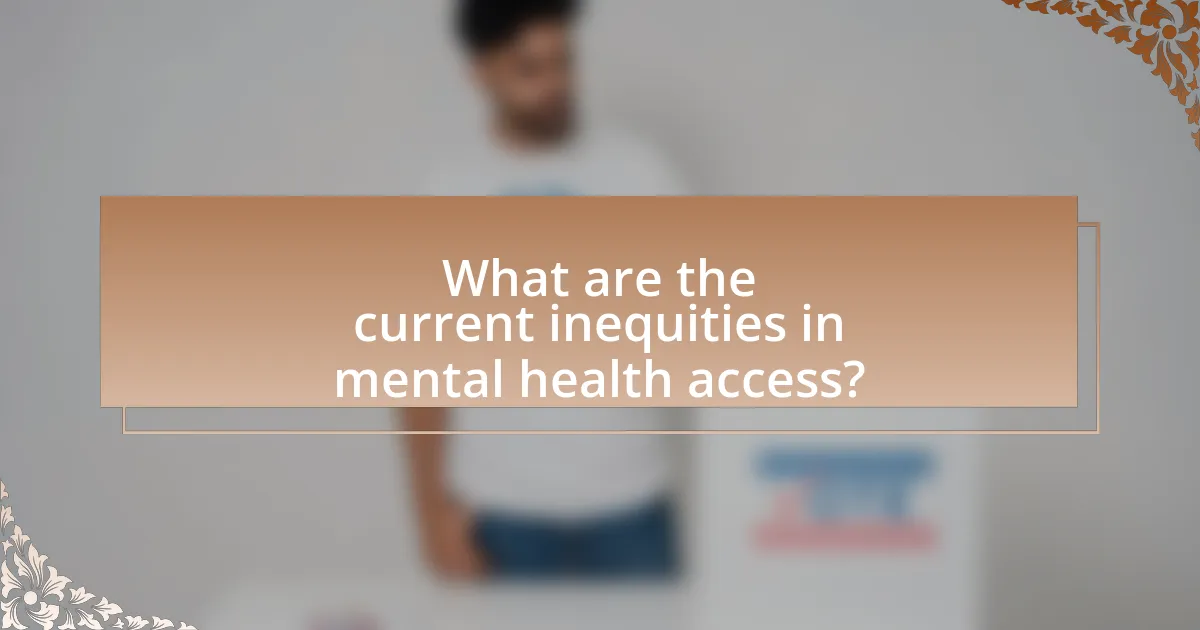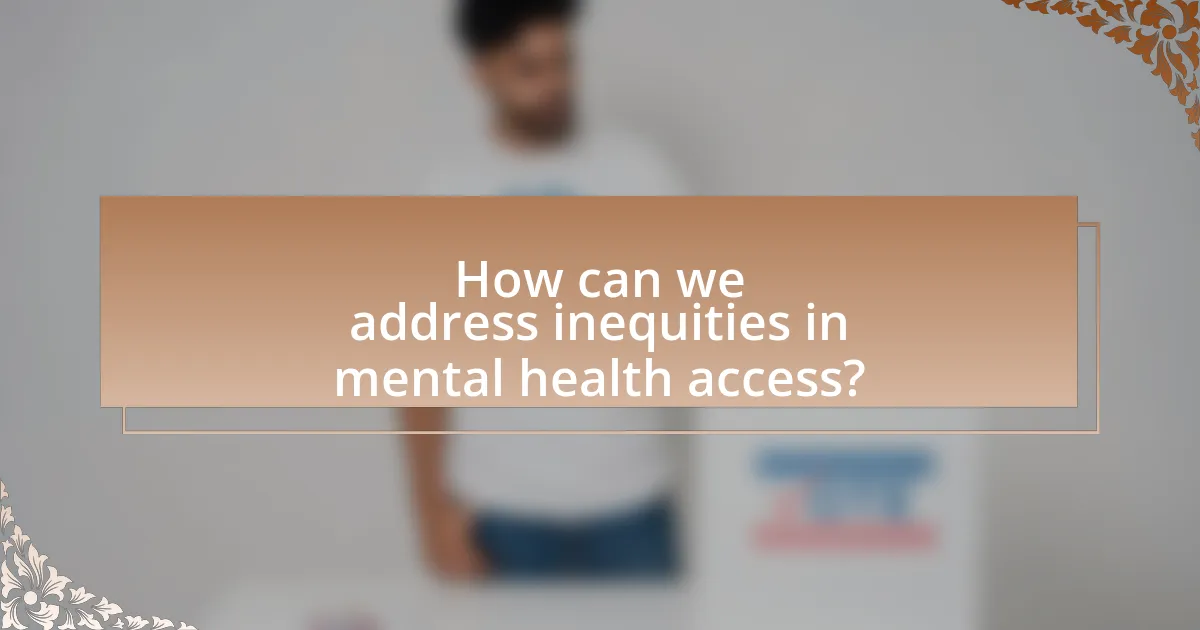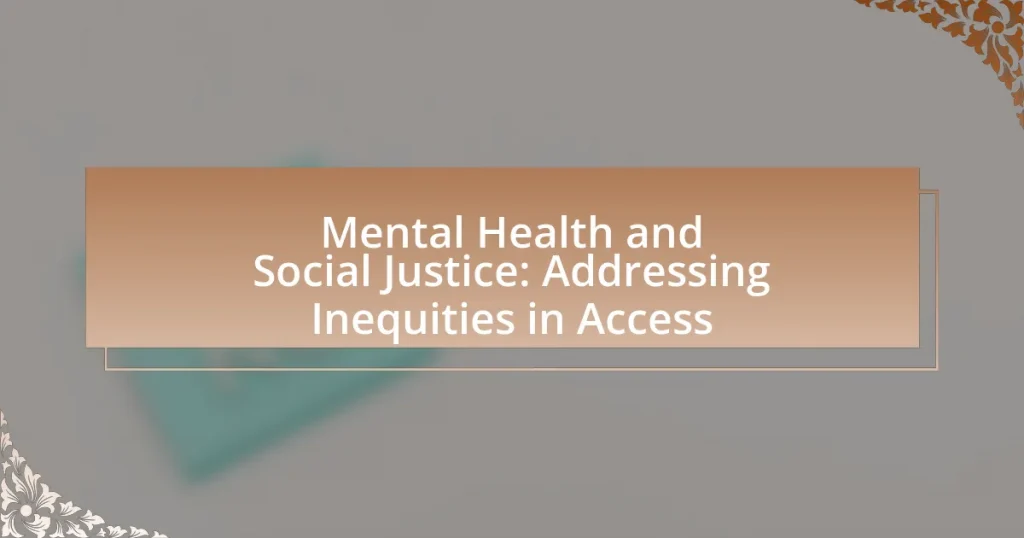Mental health and social justice are interconnected, with social justice playing a crucial role in shaping mental health outcomes by addressing systemic inequalities that hinder access to mental health care. Marginalized communities often face higher rates of mental health issues due to socioeconomic factors, discrimination, and inadequate healthcare access. Key social determinants such as income, education, and community resources significantly impact individuals’ ability to obtain necessary mental health services. The article explores current inequities in mental health access, the specific challenges faced by affected populations, and the importance of addressing these disparities to promote overall mental health equity. Strategies for improving access, including community-based programs and policy reforms, are also discussed, emphasizing the need for culturally competent care and stigma reduction initiatives.

What is the relationship between mental health and social justice?
The relationship between mental health and social justice is that social justice directly influences mental health outcomes by addressing systemic inequalities that affect access to mental health care. Research indicates that marginalized communities often experience higher rates of mental health issues due to factors such as poverty, discrimination, and lack of access to quality healthcare services. For example, a study published in the American Journal of Public Health found that individuals from low-income backgrounds are more likely to suffer from untreated mental health conditions, highlighting the need for equitable access to mental health resources as a matter of social justice. Thus, promoting social justice is essential for improving mental health outcomes across diverse populations.
How do social determinants impact mental health access?
Social determinants significantly impact mental health access by influencing individuals’ ability to obtain necessary care. Factors such as socioeconomic status, education, and community resources create barriers or facilitate access to mental health services. For instance, individuals from lower socioeconomic backgrounds often face financial constraints that limit their ability to seek treatment, as evidenced by a study published in the American Journal of Public Health, which found that low-income individuals are less likely to receive mental health care compared to their higher-income counterparts. Additionally, educational disparities can affect awareness and understanding of mental health issues, further hindering access. Community resources, such as availability of mental health professionals and support networks, also play a crucial role; areas with fewer resources often report higher rates of unmet mental health needs.
What are the key social determinants affecting mental health?
Key social determinants affecting mental health include socioeconomic status, education, social support networks, and access to healthcare. Socioeconomic status influences mental health through factors such as income, employment, and living conditions, with lower income levels correlating with higher rates of mental health issues. Education impacts mental health by affecting job opportunities and social mobility, while social support networks provide emotional and practical assistance, which can mitigate stress and promote resilience. Access to healthcare is crucial, as it determines the availability of mental health services and treatment options, with disparities often seen in marginalized communities. Research indicates that these determinants collectively shape mental health outcomes, highlighting the need for targeted interventions to address these inequities.
How do these determinants create barriers to access?
Determinants such as socioeconomic status, race, and geographic location create barriers to access by influencing individuals’ ability to obtain mental health services. For instance, individuals from lower socioeconomic backgrounds often face financial constraints that limit their access to necessary care, as evidenced by a study from the National Institute of Mental Health, which found that people with lower income levels are less likely to seek treatment due to cost-related issues. Additionally, racial and ethnic minorities frequently encounter systemic discrimination and cultural stigma, which further hinders their willingness to seek help. Geographic location also plays a critical role; rural areas often lack adequate mental health resources, leading to significant disparities in access. These factors collectively contribute to inequities in mental health service utilization, as highlighted in the report by the Substance Abuse and Mental Health Services Administration, which indicates that access to care is significantly lower in underserved communities.
Why is addressing inequities in mental health access important?
Addressing inequities in mental health access is important because it ensures that all individuals, regardless of their socioeconomic status, race, or geographic location, can receive the mental health care they need. Inequities in access lead to disparities in mental health outcomes, with marginalized populations experiencing higher rates of mental illness and lower rates of treatment. For instance, a report from the Substance Abuse and Mental Health Services Administration indicates that individuals from minority backgrounds are less likely to receive mental health services compared to their white counterparts, highlighting the critical need for equitable access to care. By addressing these inequities, society can improve overall mental health outcomes, reduce stigma, and promote social justice.
What are the consequences of inequitable access to mental health services?
Inequitable access to mental health services leads to significant disparities in mental health outcomes among different populations. Individuals in underserved communities often experience higher rates of mental health disorders, such as depression and anxiety, due to barriers like socioeconomic status, stigma, and lack of resources. For instance, a study published in the American Journal of Public Health found that individuals from low-income backgrounds are less likely to receive necessary mental health care, resulting in exacerbated symptoms and increased risk of suicide. Furthermore, inequitable access contributes to a cycle of poverty and poor health, as untreated mental health issues can impair an individual’s ability to work, maintain relationships, and engage in their community.
How does inequity in mental health access affect marginalized communities?
Inequity in mental health access significantly harms marginalized communities by exacerbating existing health disparities and limiting their ability to receive necessary care. Marginalized groups, including racial minorities, low-income individuals, and LGBTQ+ populations, often face barriers such as stigma, lack of culturally competent providers, and financial constraints, which hinder their access to mental health services. For instance, a study published in the American Journal of Public Health found that Black and Hispanic individuals are less likely to receive mental health treatment compared to their white counterparts, highlighting systemic inequities. This lack of access can lead to untreated mental health conditions, increased rates of suicide, and overall poorer health outcomes within these communities.

What are the current inequities in mental health access?
Current inequities in mental health access include disparities based on socioeconomic status, race, geographic location, and insurance coverage. Individuals from low-income backgrounds often face barriers such as lack of transportation, limited availability of services, and high out-of-pocket costs, which hinder their ability to seek care. Racial and ethnic minorities frequently encounter systemic biases and cultural stigmas that further restrict their access to mental health resources. Additionally, rural areas often lack adequate mental health facilities, forcing residents to travel long distances for care. According to the National Institute of Mental Health, nearly 60% of adults with a mental illness did not receive mental health services in the previous year, highlighting the pervasive nature of these inequities.
Which populations are most affected by mental health access inequities?
Populations most affected by mental health access inequities include racial and ethnic minorities, low-income individuals, rural residents, and LGBTQ+ communities. Racial and ethnic minorities often face systemic barriers such as discrimination and cultural stigma, which hinder their access to mental health services. Low-income individuals frequently lack insurance or financial resources, making it difficult to afford care. Rural residents encounter geographic barriers, with fewer mental health providers available in their areas. LGBTQ+ communities experience unique challenges, including discrimination and a lack of culturally competent care, which further exacerbate access issues. These disparities are supported by research indicating that these groups consistently report higher rates of unmet mental health needs compared to their counterparts.
What specific challenges do these populations face?
Populations facing mental health inequities encounter significant challenges, including limited access to mental health services, stigma surrounding mental illness, and socioeconomic barriers. Limited access is evidenced by the fact that individuals in marginalized communities often live in areas with fewer mental health providers, leading to unmet needs. Stigma contributes to reluctance in seeking help, as many individuals fear discrimination or judgment. Socioeconomic barriers, such as poverty and lack of insurance, further exacerbate these issues, making it difficult for affected individuals to afford necessary care. According to the National Alliance on Mental Illness, individuals from low-income backgrounds are less likely to receive mental health treatment compared to their higher-income counterparts, highlighting the systemic inequities present in mental health access.
How do cultural factors influence mental health access for these groups?
Cultural factors significantly influence mental health access for marginalized groups by shaping perceptions of mental illness, stigma, and help-seeking behaviors. For instance, in many cultures, mental health issues may be viewed as a sign of weakness or a source of shame, leading individuals to avoid seeking professional help. Research indicates that cultural beliefs can dictate whether individuals perceive their symptoms as medical conditions or spiritual issues, impacting their willingness to engage with mental health services. Additionally, language barriers and a lack of culturally competent care can further hinder access, as individuals may struggle to communicate their needs or feel misunderstood by providers. According to the National Alliance on Mental Illness, cultural stigma and discrimination can deter individuals from accessing necessary mental health resources, exacerbating existing disparities in care.
What systemic issues contribute to mental health access inequities?
Systemic issues that contribute to mental health access inequities include socioeconomic disparities, lack of insurance coverage, and inadequate mental health infrastructure. Socioeconomic disparities create barriers to accessing care, as individuals from lower-income backgrounds often face challenges such as transportation issues and inability to afford services. Lack of insurance coverage limits access to mental health services, with approximately 27% of adults with mental illness being uninsured, according to the National Institute of Mental Health. Inadequate mental health infrastructure, characterized by a shortage of providers and facilities, particularly in rural areas, further exacerbates these inequities, leading to significant gaps in care availability.
How do policies and funding affect mental health service availability?
Policies and funding significantly influence mental health service availability by determining the resources allocated to mental health programs and the regulatory framework governing them. For instance, increased funding can lead to the establishment of more mental health facilities, hiring of qualified professionals, and the development of community-based programs, which enhance access to care. Conversely, inadequate funding often results in service cuts, longer wait times, and limited treatment options, as seen in the 2021 National Alliance on Mental Illness report, which indicated that 56% of adults with mental illness did not receive treatment due to cost and lack of available services. Additionally, policies that prioritize mental health, such as the Mental Health Parity and Addiction Equity Act, can improve service availability by mandating equal coverage for mental health and physical health services, thus encouraging insurance providers to offer comprehensive mental health benefits.
What role does stigma play in mental health access disparities?
Stigma significantly contributes to mental health access disparities by creating barriers that prevent individuals from seeking necessary care. This stigma manifests in negative societal attitudes and discrimination against those with mental health conditions, leading to feelings of shame and isolation. Research indicates that approximately 60% of individuals with mental health issues do not seek treatment due to fear of being judged or labeled (Corrigan, 2004, “How stigma interferes with mental health care,” American Psychologist). Consequently, this reluctance to access services exacerbates existing inequalities, as marginalized groups often face heightened stigma, further limiting their access to mental health resources.

How can we address inequities in mental health access?
To address inequities in mental health access, implementing community-based mental health programs is essential. These programs can provide tailored services that meet the specific needs of underserved populations, such as low-income individuals and racial minorities. Research indicates that community mental health initiatives can reduce barriers to access, as evidenced by a study published in the American Journal of Public Health, which found that such programs increased service utilization by 30% among marginalized groups. Additionally, integrating mental health services into primary care settings can enhance accessibility, as it allows individuals to receive comprehensive care in familiar environments.
What strategies can be implemented to improve access to mental health services?
To improve access to mental health services, strategies such as increasing funding for community-based programs, integrating mental health care into primary health care settings, and utilizing telehealth services can be implemented. Increased funding allows for the expansion of services in underserved areas, addressing the shortage of mental health professionals. Integrating mental health care into primary health care facilitates early identification and treatment of mental health issues, making services more accessible. Telehealth services have been shown to reduce barriers related to transportation and stigma, allowing individuals to receive care from the comfort of their homes. According to a study published in the Journal of the American Medical Association, telehealth has significantly increased access to mental health services, particularly during the COVID-19 pandemic, demonstrating its effectiveness in reaching a broader population.
How can community-based approaches enhance mental health access?
Community-based approaches enhance mental health access by integrating services within local settings, making them more accessible to individuals who may face barriers to traditional care. These approaches often involve collaboration with local organizations, which helps to build trust and reduce stigma associated with seeking mental health support. For instance, a study published in the American Journal of Public Health found that community mental health programs significantly increased service utilization among underserved populations, demonstrating that localized support can effectively address disparities in access. By tailoring services to the specific needs of the community, these approaches ensure that mental health resources are not only available but also culturally relevant and responsive to the unique challenges faced by different groups.
What role do advocacy and policy reform play in addressing these inequities?
Advocacy and policy reform are crucial in addressing inequities in mental health access by promoting systemic changes that enhance service availability and affordability. Advocacy efforts raise awareness about mental health disparities, mobilizing communities and stakeholders to demand equitable policies. For instance, the National Alliance on Mental Illness (NAMI) has highlighted that effective advocacy can lead to legislative changes, such as the Mental Health Parity and Addiction Equity Act, which mandates equal treatment for mental health and substance use disorders in insurance coverage. Policy reform, therefore, directly impacts funding allocations, resource distribution, and the implementation of inclusive practices, ultimately working to dismantle barriers that marginalized populations face in accessing mental health services.
What best practices can organizations adopt to promote mental health equity?
Organizations can adopt several best practices to promote mental health equity, including implementing culturally competent care, increasing access to mental health services, and fostering community partnerships. Culturally competent care ensures that mental health professionals are trained to understand and respect diverse cultural backgrounds, which can improve patient engagement and outcomes. Increasing access involves removing barriers such as cost, transportation, and stigma, thereby enabling underserved populations to receive necessary services. Additionally, fostering partnerships with community organizations can enhance outreach efforts and provide tailored support to specific groups, as evidenced by initiatives that have successfully reduced disparities in mental health care access among marginalized communities.
How can organizations ensure culturally competent care?
Organizations can ensure culturally competent care by implementing comprehensive training programs for staff that focus on cultural awareness, sensitivity, and the specific needs of diverse populations. Research indicates that culturally competent care improves patient outcomes and satisfaction; for instance, a study published in the Journal of Health Care for the Poor and Underserved found that culturally tailored interventions significantly enhanced engagement and adherence among minority patients. Additionally, organizations should actively involve community members in the development of policies and practices to ensure that care is relevant and respectful of cultural differences. This approach not only fosters trust but also aligns services with the unique values and beliefs of the populations served.
What measures can be taken to reduce stigma around mental health?
To reduce stigma around mental health, implementing educational programs that promote awareness and understanding is essential. These programs can provide accurate information about mental health conditions, dispel myths, and encourage open discussions. Research indicates that education significantly decreases stigma; for instance, a study published in the journal “Psychological Medicine” found that mental health literacy programs can lead to a 50% reduction in stigma-related attitudes. Additionally, encouraging personal narratives from individuals with mental health experiences can humanize the issue and foster empathy, as evidenced by campaigns like “Time to Change” in the UK, which successfully reduced stigma through storytelling.
What are practical steps individuals can take to support mental health equity?
Individuals can support mental health equity by advocating for policies that promote equal access to mental health services. Engaging in community outreach programs can help raise awareness about mental health issues and the disparities faced by marginalized groups. Additionally, individuals can educate themselves and others about mental health conditions, reducing stigma and fostering understanding. Supporting local mental health organizations through volunteering or donations can also contribute to resources for underserved populations. Research indicates that community-based interventions can significantly improve access to mental health care, particularly in low-income areas, highlighting the importance of grassroots efforts in promoting equity.










